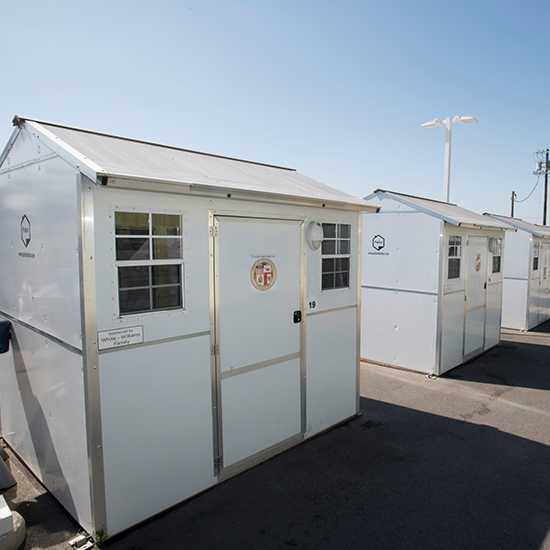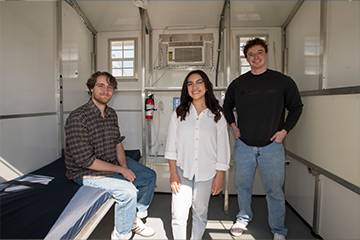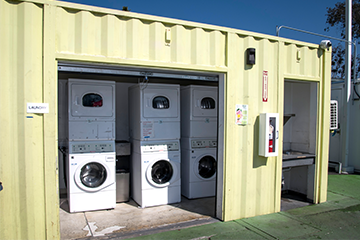Capstone Students Study Tiny Home Villages for the Unhoused

Pepperdine School of Public Policy (SPP) received a grant from the A-Mark Foundation to evaluate the costs associated with operating and maintaining tiny home villages in Los Angeles, California, as an interim solution to homelessness. The project sought to achieve a greater understanding of funding breakdowns between local government entities and nonprofit organizations.
The capstone project at SPP is the cumulation of the students’ final months of the Master of Public Policy (MPP) degree program and requires students to develop and present a major public policy design and implementation plan using an actual agency or situation. This integrative experience builds leadership skills and generates deliverables for a student's research portfolio and resume.
The A-Mark Foundation is a nonprofit organization whose mission is to present unbiased research on political and social topics. Led by SPP faculty member Dr. Marlon Graf and A-Mark Foundation’s vice president and 2001 Seaver College graduate Tracey DeFrancesco, three students completed a capstone study on tiny home villages. Commonly referred to as cabin communities, which operate in a joint effort between the government and nonprofits, tiny home villages provide wraparound support to those experiencing homelessness through shelter, mental health support, food, and various other services.
The School of Public Policy members included Celeste Benitez (MPP ’24), Cooper Conway
(MPP ’24), and Declan Maddern (MPP ’24). 
“The project piqued my interest as I live in Vancouver, Washington, a suburb of Portland, Oregon,” said Conway. “We notably have a large homeless population that I grew up serving. Recently, on my trips back home, I noticed the tiny home villages popping up on the side of highways and was curious to learn more. I was surprised by how much California's inability to build enough housing generally impacts the effectiveness of these tiny home villages in achieving their mission.”
The team used quantitative and qualitative tools to analyze the data they gathered through public records requests, research, and interviews. They obtained the quantitative data from the Los Angeles Homeless Services Authority (LAHSA) through a public records request. This information spanned from the 2021 to 2023 operating years. The data from individual tiny home village budgets included federal and county fund allocations for constructing and operating tiny home villages. Moreover, the budgets included expenses such as rehabilitation, personnel, programming, and supportive services.
For the qualitative data, the research team conducted ten one-on-one, semi-structured interviews with key stakeholders to gain insight into the implementation, operation, and maintenance of tiny home communities in Los Angeles.
“Real world projects are invaluable for students to gain experience working with clients and stakeholders. As a Pepperdine alumna, I am especially proud of how professionally the SPP student researchers conducted themselves in producing this comprehensive report. They uncovered new information about the costs of operating tiny home villages for people experiencing homelessness that will be a valuable read for policymakers. It makes a great companion to A-Mark's earlier report on the costs of building tiny home villages,” shared Tracey DeFrancesco (Seaver College ’01).
The research study findings demonstrate that although tiny homes are effective at moving people off the street and providing desperately needed services, the lack of affordable permanent housing options severely hinders their effectiveness as temporary shelter, as many have no option but to stay indefinitely. This forces these organizations to increasingly become permanent housing providers, which is neither their mission nor realistic given their budget.
A few data highlights included:
- Most government-funded tiny home village budget expenditures are used for supportive and financial services, hotel vouchers, and non-personnel operating costs.
- Tiny home villages often use less money than they are awarded yearly.
- Tiny home villages used no federal funding for the first time in 2023.
- Key stakeholders widely view tiny home villages as cheaper and quicker to build than other interim housing solutions, such as hotel conversions.
- Tiny home village operators estimate a $20-30 daily funding gap from government entities to provide security, meals, case management, client services, and staff per villager.
- Reimbursement to NGO operators takes three months, limiting their ability to respond
quickly to issues such as extreme weather, unforeseen repairs, or an influx of individuals
suffering from homelessness.
Information and data transparency from the Los Angeles Homeless Services Authority (LAHSA) was repeatedly cited as a concern in interviews.
 The study concluded with the following analysis:
The study concluded with the following analysis:
“The aim of this study was to shed light on the current budgetary breakdown of tiny home communities in LA County, to determine if they are properly serving their purpose in reducing homelessness . . . We recommend increasing the availability of permanent housing through zoning reform, increasing funding for essential mental health services, mandating increased communication and information-sharing between shareholders, and implementing a long-term and flexible approach to budget allocation. Adopting these policy recommendations will reduce inefficiency in this critical service and better accomplish the aims of these tiny home communities.”